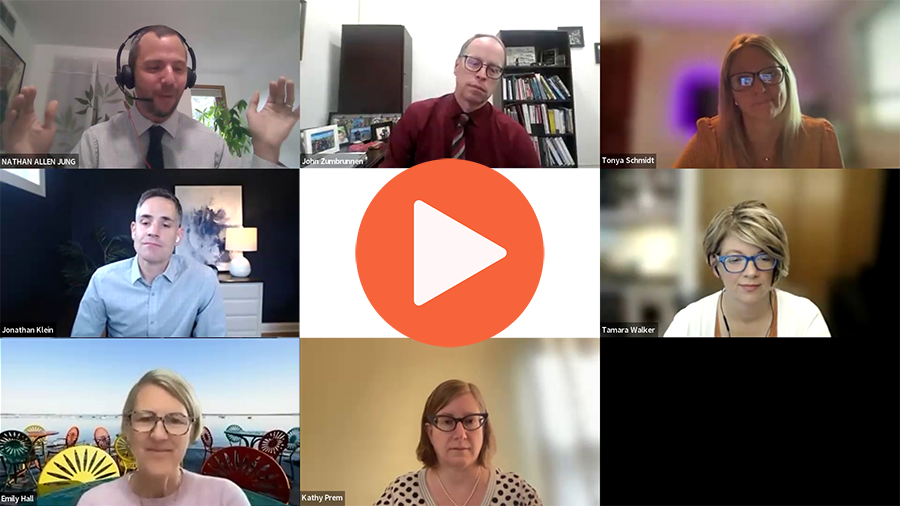There’s a looming question on the minds of many instructors and students as they return to the UW–Madison campus and prepare for the start of the fall semester: What to do (and not do) with generative artificial intelligence tools like ChatGPT in the classroom.
A group of faculty and staff with experience using AI tools in their courses, thinking about AI policies and principles, and supporting instructors gathered last week for a virtual town hall about the challenges and opportunities ChatGPT and other generative AI tools present for teaching and learning at the college level.
The town hall was part of Exploring Artificial Intelligence @ UW–Madison, a series of free webinars examining topics related to AI research and application, sponsored by the Division of Information Technology and the Data Science Institute.
Watch the recording of our “Town Hall on AI and Teaching & Learning” webinar. You can also watch the recording with audio descriptions.
Led by John Zumbrunnen, UW–Madison senior vice provost for academic affairs, the panelists discussed a wide range of topics, including:
- Using AI as a teaching and learning tool
- Setting clear expectations for students in syllabi and assignments
- Rethinking assignments to emphasize process over product
- Teaching students to use AI effectively while watching out for issues of bias and accuracy
- Understanding the limitations of tools that promise to detect AI-generated content
- Considering equity when affluent students can afford higher-quality AI tools
- Fostering an educational environment built on exploration, trust and transparency
Zumbrunnen and the panelists highlighted guiding principles for instructors, sample AI statements for course syllabi and a statement on the use of generative AI by UW Chief Information Security Officer Jeffrey Savoy. UW instructors can find those resources and more on the Division for Teaching and Learning’s Generative AI – Instructional Opportunities and Challenges page.
The panel discussed why it’s important for instructors to educate themselves about AI tools and be upfront and clear with students about their expectations.
“Make sure you’re sharing with your students if you don’t want them to use (AI) that it’s not because, ‘Oh gosh, this is another new thing,’” said Emily Hall, a distinguished teaching faculty member who directs UW’s Writing Center and Writing Across the Curriculum. “I know, I feel that way too. But we want to have legitimate learning goals.”
Instructors should also be transparent about their thought process and how challenging it is to incorporate a new, rapidly developing technology into their courses, they said.
“Anytime I talk about AI, I have to add the caveat at the end that things are moving really fast, and I reserve the right to change my mind,” said Nathan Jung, a teaching faculty member in the College of Engineering, who shared several strategies he’s employed using AI to help his students engage with his lessons in new ways.
They also addressed the anxiety and reflexive distrust many have for AI tools and cautioned instructors to avoid distrusting their students and relying on AI detection tools, which are opaque and prone to error.
“We have to be careful not to create a climate of suspicion,” Zumbrunnen said. “Try not to feel suspicious of your students. Try to trust them and create that shared sense of community. We’re all here to learn.”
For now, instructors can access guidance and resources on the Division for Teaching and Learning’s Generative AI – Instructional Opportunities and Challenges page. As the semester progresses, Zumbrunnen said the division is considering what further resources and dialog opportunities would be helpful for instructors. The university is also evaluating whether and how to offer AI tools at an institutional level to help ensure equitable, safe and secure access to this emerging and transformative technology, said Tamara Walker, director of DoIT Academic Technology and associate vice provost for learning technologies.
In the meantime, instructors can submit questions, support requests and ideas to the division using an online form.
Related resources
- Exploring Artificial Intelligence @ UW–Madison – Division of Information Technology
- Generative AI – Instructional Opportunities and Challenges – Division for Teaching and Learning
- AI Statements for Course Syllabi – Division for Teaching and Learning
- Statement on Use of Generative AI from CISO – Division of Information Technology
- Generative AI Use and Policies – Division of Information Technology
- Considerations for Using AI in the Classroom – L&S Instructional Design Collaborative
- AI and ChatGPT – Center for Teaching, Learning & Mentoring
- Locally Sourced: Writing Across the Curriculum Sourcebook – Writing Across the Curriculum Program
- AI in the Writing Center: Small Steps and Scenarios – Writing Center
Further reading from the panelists and chat
- How Will Artificial Intelligence Change Higher Ed? – The Chronicle of Higher Education
- Why Universities Should Be More Like Monasteries – The New York Times
- This is not us: Disproving common Irish stereotypes – EPIC: The Irish Emigration Museum
- An AI detector mislabeled nearly every essay written by a non-native English speaker as being written by a bot – Insider
- Lawyer Who Used ChatGPT Faces Penalty for Made Up Citations – The New York Times
- Why AI detectors think the US Constitution was written by AI – Ars Technica
- How is ChatGPT’s behavior changing over time? – arXiv:2307.09009
- Unbundling Harvard: How The Traditional University Is Being Disrupted – CB Insights

